Follow the Rain – Radical Attention to Place
January 14, 2023
“The Kalapuyas had originally a six month calendar that organized the spring, summer, and fall according to the camas growing cycle. The winter did not have any particular months as it was a long period where it was best that people stayed indoors because of the extensive rainfall.”
-David G. Lewis
I read this in Quartux, an online journal of indigenous anthropology, a couple days after Christmas from the cozy nest of my couch, on the lands of the Kalapuya, cat in lap, rain patterning the windows with water stars, bare tree limbs dancing in the wind beyond the pane. A winter of no particular months, a season to dream outside of time, only roots unseen growing deeper, following the opening course of rainfall into the earth. What’s a gardener to do but be present for it? To be present to the pause that we now call January, a name given to mark the beginning of a cycle where once it was marked only by rainfall.
But, I do go outside. Gore-Tex and the requirements of modern life make it possible and necessary. I go out in the rain and walk the garden paths, sensing the saturation under the soles of my boots, dipping my hands into snug denim pockets for warmth, and I observe: the revealed structure of deciduous trees, the rare perennials wearing evergreen leaves, the winter-bare bones of the garden.
January is typically the month gardeners are encouraged to dream up new projects, to peruse seed catalogues, and scroll inspiring photos of admired schemes from far off lands—Dutch, British, Japanese, East Coast, and Midwest styles dominate the media. We of the Pacific region, young and impressionable, scrabble to model our gardens after these older schools and to demonstrate some form of refinement and sophistication. Boxwood hedges line brick walkways in elite Portland neighborhoods, Piet Oudolf style perennials crowd nursery grounds, Japanese maples remain the most coveted specimen tree. I admit, there’s a lot to learn from the masters.
But, in this new year, let a radical inquiry of place guide new garden projects. Welcome the joy of following your curiosity. Directly observe what’s out your door, in your neighborhood, and in the fields and forests it connects to. Become a collaborator with nature, with place, with the ground that is your home. Learn what you can about indigenous peoples. They lived here for centuries before European settlers decimated their deep knowledge of this place. Dive into deep time reading the geologic story that underlies everything. Find regional poetry, memoirs, fiction to add another layer of story to your understanding of where you live. Abandon consumerist impulses to buy the latest trending cultivar. Yes, it’s time to get radical in our garden making.
What does it mean to be radical? It’s to be rooted in place, to make transformative change, to challenge the status quo, to come from deep understandings.
To nurture my own radicalization this month, I’m attending to my place with curiosity. Regular walks not only in my small garden, but up nearby Skinner’s Butte and along the swollen Willamette River offer plenty to be curious about. I welcome questions that bring me closer to the ground, kneeling in the mud, nose to mushrooms, fingers to stone.
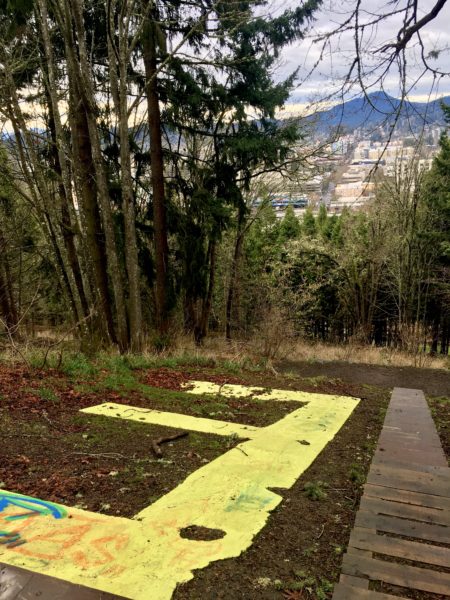
The Big E on Skinner’s Butte with a view of Eugene and Spencer’s Butte
Out my front door, I walk down stone stairs side-dressed for the season with fresh green licorice fern (Polypodium glycyrhizza), such a smart color against the rain-black basalt. Passing my neighbor Jane’s hellstrip, I see the same frilled green pattern but, this time, it’s sun loving California poppy (Eschscholzia californica) leaves in a paler seaglass hue of winter growth. One summer, this hellstrip was all poppies and bees, a neighborhood wonder. Today I see more weedy grass than poppies. Maybe I’ll share some Douglas aster (Symphyotricum subspicatum) or pearly everlasting (Anaphalis margaritacea) with Jane. Those vigorous natives could help outcompete the grasses.
Continuing on, I make my way through the Owen Rose Garden where a small evergreen tree catches my eye. What is it? Leaves leathery like some viburnums I know, growth like the quick sketch we landscape designers use to depict “columnar”. A few photos sent to my nursery pals, fellow plant-mystery-lovers, reveals an id: Chinese fighazel (Sycopsis sinensis). Grows well in dry shade! What a perfect option for a tight spot in a small urban garden that needs evergreen screening. Perhaps you have such a spot? Asking nurseries for unusual plants encourages diversity and resilience in our planted landscapes.
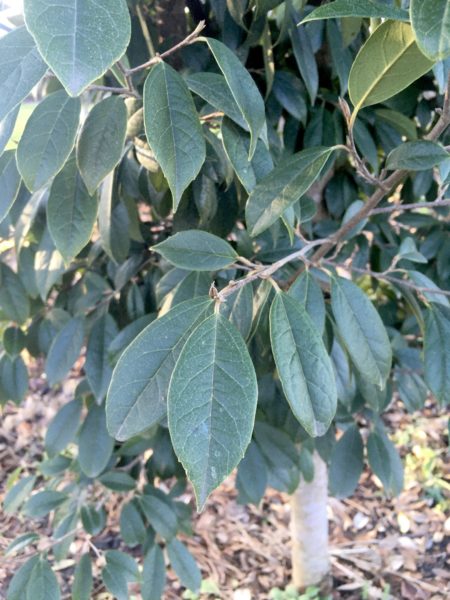
Chinese Fighazel in it’s evergreenery at the Rose Garden
Next, I near the swollen Willamette River and make my body wide and swift in sympathy with the energizing effect of winter on water. My leash-tugging dog feels this flow, too. The redosier dogwood (Cornus sericea) is knee deep in the current, blood maroon twigs swaying. I imagine the structure of the roots that wrap and grasp the bank, tenacious, holding. Quite a garden worthy trait for you with a wet, sloped site.
Avoiding another dog, we veer up the bank to the bike path. Its flanks are loose with layer upon layer of big leaf maple (Acer macrophyllum) leaves, blown from the park lawns onto this marginal zone like a heap of laundry piled on the bed. What if your garden were allowed to have such a zone rather than shoving them all to the street for diesel chugging trucks to remove? The best soil amendment is free if you can give some space for leaves to transform to leaf mold.
Up on Skinner’s Butte, the sawdust-and-gas smell and buzz of chainsaws explains a trail closure sign. Crews of early rising workers dressed in bright yellows, greens, and oranges are removing bird cherry (Prunus avium), Norway maple (Acer platanoides), holly (Ilex aquifolium), and singleseed hawthorn (Crataegus monogyna) from the forested slope. “Invasive brush” the sign calls them. I think about the beauty of the spring cherry flowers and feel a pang of loss. But, then I look down, where once ivy covered all, and I now see countless candy flower (Claytonia sibirica) seedlings, their cotyledons long and narrow like helicopter blades. What will be allowed to grow with the removal of the weedy cherries and other non-natives? Vine maple? Cascara? Chokecherry? I’ve only seen of few of these native trees here. What would be able to grow if you were to remove that sunburnt rhododendron by your front door? Or that insect infested birch? Or that rangy, self-seeding laurel? I give you permission to take it out in favor of something better.
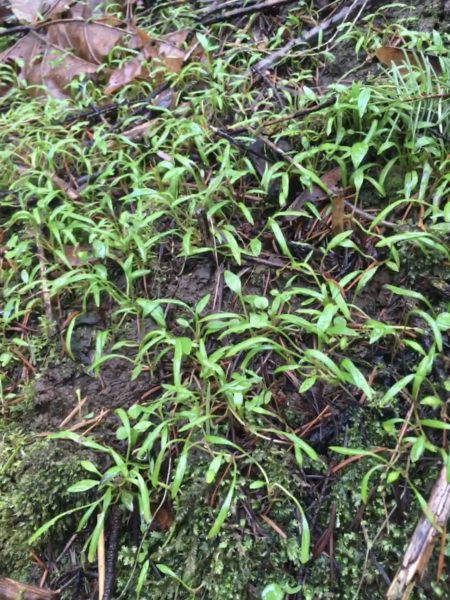
Where once ivy smothered all, now candy flower greens the ground
Looping back toward home, I pass my neighbor Robert wearing more layers than he pushes in his cart. He knows this place, living outdoors in it all hours of day and night, all seasons. What do I know of it? What do you know of the place you call home?
A flock of small-beaked birds eat seeds high in an Autumn Purple ash tree (Fraxinus americana ‘Autumn Purple’). They’re brown, one with a bit of a rusty coloring to his face. Back home, I see the first hellebore buds emerging, knuckling up from chocolate ground. I breathe in and prepare for the day’s work, holding my curiosity about all I’ve seen as questions to follow later, in the dark hours of the winter evening, researching, following the rabbit hole down, learning more, feeding my garden making dreams with the soul of this place.
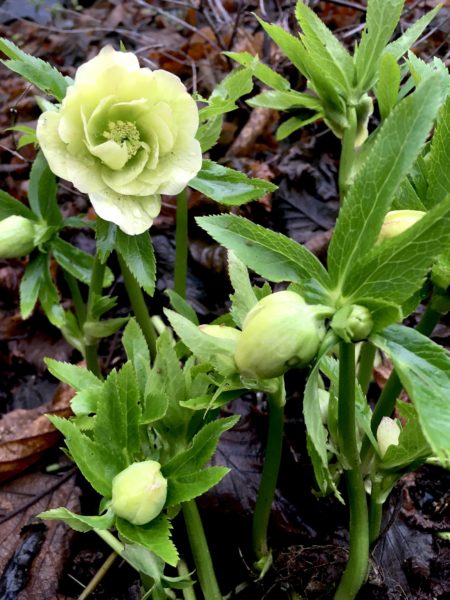
This ‘Golden Lotus’ hellebore is always the earliest is my garden
“It’s very local…We’re going to be looking at how to strengthen microclimates, how to create these micro-ecosystems that, as humans, we can tend and we can be watching and we can belong. It’s really about belonging. That’s it.” –Judy BlueHorse Skelton
Showing your garden a locally inspired kind of attention is another way to practice self-love and self-care. Because what is your home ground but an extension of yourself? It is the place you as a human interconnect with plants and animals, water and soil and weather, with life. To approach this porous edge of self/nature with a renewed sense of context, with an understanding of the cultural, geological, and botanical stories that have unfolded here, that continue to unfold, is as radical as rain training roots to grow to greater depths. “One of the best guides to how to be self-loving is to give ourselves the love we are dreaming about receiving from others,” wrote bell hooks in her 1999 book All About Love. What kind of love can you give yourself as one who tends a garden? I suggest acceptance, celebration even, of the inherent nature of your place. Abandon fashions from other climates. Embrace radical place-based care. Let January be the month to rekindle a rooted sense of the sacredness of place.
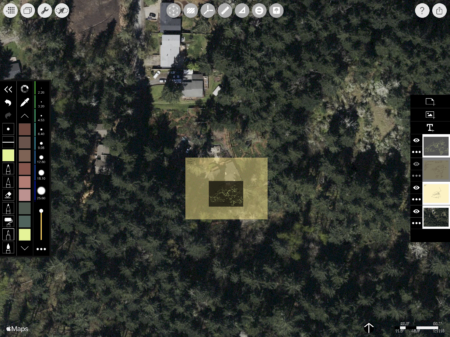
I like to start a garden design from a satellite image. Context is everything.

I am a new reader and find your articles and writing so lovely and inviting. Thank you for creating these wonderful visions in my head married with all the super insights about the nature of plants and their homes.
My sister and her husband have an organic farm and draft horse workshop outside of Doreena OR on the Row Rover- Ruby and Amber’s Organic Oasis. I am going to share your link with her and my gardener friends who would also appreciate your artistic, beautiful words and connection to nature life.
Thank you so much!!
Kim Woolhouse
Puyallup, WA.
Thank you so much Kim! I’ve enjoyed you sister’s good produce for years from the farmer’s market, one of the best of our many local growers! I’d love to connect with her further.